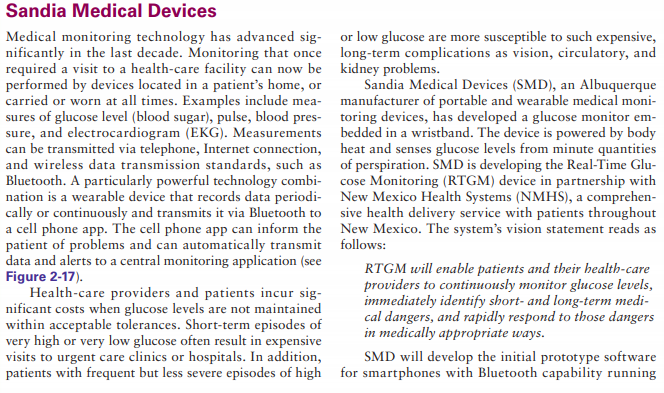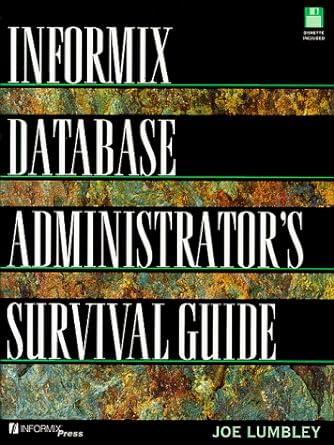


Sandia Medical Devices Medical monitoring technology has advanced sig- or low glucose are more susceptible to such expensive, nificantly in the last decade. Monitoring that once long-term complications as vision, circulatory, and required a visit to a health-care facility can now be kidney problems. performed by devices located in a patient's home, or Sandia Medical Devices (SMD), an Albuquerque carried or worn at all times. Examples include mea- manufacturer of portable and wearable medical moni- sures of glucose level (blood sugar), pulse, blood pres- toring devices, has developed a glucose monitor em- sure, and electrocardiogram (EKG). Measurements bedded in a wristband. The device is powered by body can be transmitted via telephone, Internet connection, heat and senses glucose levels from minute quantities and wireless data transmission standards, such as of perspiration. SMD is developing the Real-Time Glu- Bluetooth. A particularly powerful technology combi- cose Monitoring (RTGM) device in partnership with nation is a wearable device that records data periodi- New Mexico Health Systems (NMHS), a comprehen- cally or continuously and transmits it via Bluetooth to sive health delivery service with patients throughout a cell phone app. The cell phone app can inform the New Mexico. The system's vision statement reads as patient of problems and can automatically transmit follows: data and alerts to a central monitoring application (see Figure 2-17). RTGM will enable patients and their health-care Health-care providers and patients incur sig. providers to continuously monitor glucose levels, nificant costs when glucose levels are not maintained immediately identify short- and long-term medi- within acceptable tolerances. Short-term episodes of cal dangers, and rapidly respond to those dangers very high or very low glucose often result in expensive in medically appropriate ways. visits to urgent care clinics or hospitals. In addition, SMD will develop the initial prototype software patients with frequent but less severe episodes of high for smartphones with Bluetooth capability running Data transmitted to cell phone via Bluetooth Server archives data and generates alerts O Alexey Boldin/Shutterstock.com Data sent to/from server via wireless Internet Stocklite/Shutterstock.com Jon Le-Bon/ Shutterstock.com Wristband continuously measures glucose level Blue Vista Design Shutterstock.com Medical personnel monitor levels/trends and plan response Cell phone app routes date and interacts with patient for alerts and monitoring Communication with patient via voice or text messages Rehan Qureshi/Shutterstock.com the Google Android operating system. If successful, NMHS and its patients will have free use of the soft- ware and SMD will resell the software to other health systems worldwide. 1. Who are RTGM's stakeholders? Should NMHS's patients be included in defining the system requirements? Why or why not? Should RTGM interact with medical professionals other than physicians? Why or why not? 2. If you were the lead analyst for RTGM, how would you determine the requirements? Be specific in your answer. List several questions you need answered. 3. What are the primary functional requirements for the system as described so far in the case? 4. Are the parameters for alerting patients and medical personnel the same for every patient? Can they vary over time for the same patient? What are the implications for the system's func- tional requirements? 5. Briefly describe some possible nonfunctional re- quirements for RTGM. Running Case Study - Sandia Medical Devices 1. Create a System Vision Document using the outline in Figure 1-8 in chapter 1. Include sections for the Problem Description, System Capabilities, and Business Benefits. You should include at least one paragraph for the problem description, five capabilities and five business benefits for the sections respectively. 2. Using the case study description in chapter 2, describe the following aspects for this project: a. List at least three stakeholders b. List at least ten functional requirements, as well as at least three usability, reliability, security, and performance requirements each for the system c. List at least five sample questions you would ask of the stakeholders in the system when gathering requirements for the system 3. Using the textbook material from chapters 3-5, list the following aspects for your use case analysis: a. Define at least three actors for your use cases b. Define at least five use cases for the system. These should be in a simple actor->verb form (e.g., actor 1 does the following in the system) at a granular level. c. Include a use case diagram for your actors and use cases. c. Write a fully developed use case of what you consider to be the most important use case using the model template in Figure 5-2. 4. List at leave five high-level security controls for your subsystems in the project using the broad categories in chapter six of the textbook. Also, list specifically what data you would encrypt and what would be the risks and potential consequences if the data were exposed to hackers. Sandia Medical Devices Medical monitoring technology has advanced sig- or low glucose are more susceptible to such expensive, nificantly in the last decade. Monitoring that once long-term complications as vision, circulatory, and required a visit to a health-care facility can now be kidney problems. performed by devices located in a patient's home, or Sandia Medical Devices (SMD), an Albuquerque carried or worn at all times. Examples include mea- manufacturer of portable and wearable medical moni- sures of glucose level (blood sugar), pulse, blood pres- toring devices, has developed a glucose monitor em- sure, and electrocardiogram (EKG). Measurements bedded in a wristband. The device is powered by body can be transmitted via telephone, Internet connection, heat and senses glucose levels from minute quantities and wireless data transmission standards, such as of perspiration. SMD is developing the Real-Time Glu- Bluetooth. A particularly powerful technology combi- cose Monitoring (RTGM) device in partnership with nation is a wearable device that records data periodi- New Mexico Health Systems (NMHS), a comprehen- cally or continuously and transmits it via Bluetooth to sive health delivery service with patients throughout a cell phone app. The cell phone app can inform the New Mexico. The system's vision statement reads as patient of problems and can automatically transmit follows: data and alerts to a central monitoring application (see Figure 2-17). RTGM will enable patients and their health-care Health-care providers and patients incur sig. providers to continuously monitor glucose levels, nificant costs when glucose levels are not maintained immediately identify short- and long-term medi- within acceptable tolerances. Short-term episodes of cal dangers, and rapidly respond to those dangers very high or very low glucose often result in expensive in medically appropriate ways. visits to urgent care clinics or hospitals. In addition, SMD will develop the initial prototype software patients with frequent but less severe episodes of high for smartphones with Bluetooth capability running Data transmitted to cell phone via Bluetooth Server archives data and generates alerts O Alexey Boldin/Shutterstock.com Data sent to/from server via wireless Internet Stocklite/Shutterstock.com Jon Le-Bon/ Shutterstock.com Wristband continuously measures glucose level Blue Vista Design Shutterstock.com Medical personnel monitor levels/trends and plan response Cell phone app routes date and interacts with patient for alerts and monitoring Communication with patient via voice or text messages Rehan Qureshi/Shutterstock.com the Google Android operating system. If successful, NMHS and its patients will have free use of the soft- ware and SMD will resell the software to other health systems worldwide. 1. Who are RTGM's stakeholders? Should NMHS's patients be included in defining the system requirements? Why or why not? Should RTGM interact with medical professionals other than physicians? Why or why not? 2. If you were the lead analyst for RTGM, how would you determine the requirements? Be specific in your answer. List several questions you need answered. 3. What are the primary functional requirements for the system as described so far in the case? 4. Are the parameters for alerting patients and medical personnel the same for every patient? Can they vary over time for the same patient? What are the implications for the system's func- tional requirements? 5. Briefly describe some possible nonfunctional re- quirements for RTGM. Running Case Study - Sandia Medical Devices 1. Create a System Vision Document using the outline in Figure 1-8 in chapter 1. Include sections for the Problem Description, System Capabilities, and Business Benefits. You should include at least one paragraph for the problem description, five capabilities and five business benefits for the sections respectively. 2. Using the case study description in chapter 2, describe the following aspects for this project: a. List at least three stakeholders b. List at least ten functional requirements, as well as at least three usability, reliability, security, and performance requirements each for the system c. List at least five sample questions you would ask of the stakeholders in the system when gathering requirements for the system 3. Using the textbook material from chapters 3-5, list the following aspects for your use case analysis: a. Define at least three actors for your use cases b. Define at least five use cases for the system. These should be in a simple actor->verb form (e.g., actor 1 does the following in the system) at a granular level. c. Include a use case diagram for your actors and use cases. c. Write a fully developed use case of what you consider to be the most important use case using the model template in Figure 5-2. 4. List at leave five high-level security controls for your subsystems in the project using the broad categories in chapter six of the textbook. Also, list specifically what data you would encrypt and what would be the risks and potential consequences if the data were exposed to hackers









